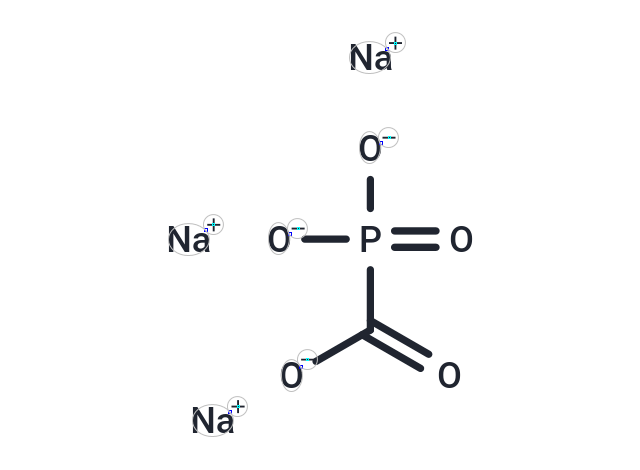Shopping Cart
- Remove All
 Your shopping cart is currently empty
Your shopping cart is currently empty
Foscarnet sodium (Phosphonoformate) is an antiviral agent used in the treatment of cytomegalovirus retinitis. Foscarnet also shows activity against human herpesviruses and HIV.

| Pack Size | Price | Availability | Quantity |
|---|---|---|---|
| 50 mg | $41 | In Stock | |
| 100 mg | $66 | In Stock |
| Description | Foscarnet sodium (Phosphonoformate) is an antiviral agent used in the treatment of cytomegalovirus retinitis. Foscarnet also shows activity against human herpesviruses and HIV. |
| In vitro | Foscarnet Sodium is able to penetrate into cells and inhibit viral replication by inhibiting viral DNA synthesis. Foscarnet Sodium (300 μM) displays a more than 95% inhibition on HTLV-III reverse transcriptase activity in H9 cells infected with HTLV-III. [1] Foscarnet Sodium has a low cellular toxicity, but shows an inhibition of cell proliferation at high concentrations, which is reversed after drug removal. Incubation 0.5-1 mM Foscarnet Sodium with HeLa cells or primary human lung fibroblast for 24-48 hr inhibited 50% DNA synthesis and/or cell proliferation. [1] Foscarnet Sodium is able to bind with the heparin-binding domain of FGF2 and inhibits FGF2 induced cell proliferation. Foscarnet Sodium (25 μM) treating HUVEC cells for 48 hr reduced FGF2-induced cellular proliferation by 20%. Foscarnet Sodium (0.5-1 mM) reduced the 24h proliferation rate of CAL-62 cell, a Human thyroid anaplastic carcinoma cell line which expresses FGF2, to nearly 80%. [2] |
| In vivo | Foscarnet Sodium display an efficient therapy effect on animal with virus diseases, such as cutaneous infection, herpes keratitis, genital infection, or systemic and interacerebral infection. For example, Foscarnet Sodium (100 mM) applied at initiated 48 h post inoculation with twice daily applications of 30 μL for 4 days, displays a more than 70% reduction in cumulative score after inoculation with HSV-1 strain C42. Foscarnet Sodium (20 mg/kg) given as an aerosol to mice infected with murine CMV caused a reduction of 60% in lung titers. [1] |
| Kinase Assay | Reverse transcriptase assays: Reverse transcriptase assays are carried out in a reaction mixture (50 μL) containing 50 mM Tris-HCl (pH 7.5), 5 mM DTT, 100 mM potassium chloride, 0.01% Triton X-100 or NP40, 10 μg/ml (dT)15.(A)n as template primer and [3H] deoxythymidine triphospahate. The reaction mixture is incubated for 1 hr at 37 ℃ and stopped by the addition of 50 μg of yeast tRNA and 2 mL of 10% solution of trichloroacetic acid containing 1 mM sodium pyrophosphate. The samples are filtered on filters (0.45 μm), washed first with 5% TCA solution for 5 times and then with 2 ml of 70% ethanol. The filters are dried, scintillation fluid is added and the radioactivity counted in a counter. |
| Cell Research | CAL-62 cells are placed on 96 well plates at 8×103 cells/well in 100 μL DMEM for 24 h. Then medium is replaced by fresh DMEM with or without foscarnet. After 48 h of incubation, 20 μL of CellTiter 96AQ solution is added to the cells and incubated for 2-4 h. The quantity of formazan product as measured by the absorbance at 492 nm.(Only for Reference) |
| Synonyms | Phosphonoformate |
| Molecular Weight | 191.95 |
| Formula | CNa3O5P |
| Cas No. | 63585-09-1 |
| Smiles | C(=O)([O-])P(=O)([O-])[O-].[Na+].[Na+].[Na+] |
| Relative Density. | no data available |
| Color | White |
| Appearance | Solid |
| Storage | Powder: -20°C for 3 years | In solvent: -80°C for 1 year | Shipping with blue ice/Shipping at ambient temperature. | ||||||||||||||||||||
| Solubility Information | H2O: 3 mg/mL (15.63 mM), Sonication is recommended. DMSO: < 1 mg/mL (insoluble or slightly soluble) Ethanol: < 1 mg/mL (insoluble or slightly soluble) | ||||||||||||||||||||
Solution Preparation Table | |||||||||||||||||||||
H2O
| |||||||||||||||||||||

Copyright © 2015-2025 TargetMol Chemicals Inc. All Rights Reserved.